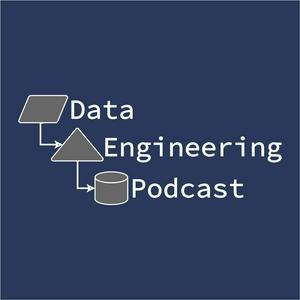493 episodios

From Data Engineering to AI Engineering: Where the Lines Blur
14/12/2025 | 26 min
Summary In this solo episode of the Data Engineering Podcast, host Tobias Macey reflects on how AI has transformed the practice and pace of data engineering over time. Starting from its origins in the Hadoop and cloud warehouse era, he explores the discipline's evolution through ML engineering and MLOps to today's blended boundaries between data, ML, and AI engineering. The conversation covers how unstructured data is becoming more prominent, vectors and knowledge graphs are emerging as key components, and reliability expectations are changing due to interactive user-facing AI. The host also delves into process changes, including tighter collaboration, faster dataset onboarding, new governance and access controls, and the importance of treating experimentation and evaluation as fundamental testing practices. Announcements Hello and welcome to the Data Engineering Podcast, the show about modern data managementData teams everywhere face the same problem: they're forcing ML models, streaming data, and real-time processing through orchestration tools built for simple ETL. The result? Inflexible infrastructure that can't adapt to different workloads. That's why Cash App and Cisco rely on Prefect. Cash App's fraud detection team got what they needed - flexible compute options, isolated environments for custom packages, and seamless data exchange between workflows. Each model runs on the right infrastructure, whether that's high-memory machines or distributed compute. Orchestration is the foundation that determines whether your data team ships or struggles. ETL, ML model training, AI Engineering, Streaming - Prefect runs it all from ingestion to activation in one platform. Whoop and 1Password also trust Prefect for their data operations. If these industry leaders use Prefect for critical workflows, see what it can do for you at dataengineeringpodcast.com/prefect.Composable data infrastructure is great, until you spend all of your time gluing it together. Bruin is an open source framework, driven from the command line, that makes integration a breeze. Write Python and SQL to handle the business logic, and let Bruin handle the heavy lifting of data movement, lineage tracking, data quality monitoring, and governance enforcement. Bruin allows you to build end-to-end data workflows using AI, has connectors for hundreds of platforms, and helps data teams deliver faster. Teams that use Bruin need less engineering effort to process data and benefit from a fully integrated data platform. Go to dataengineeringpodcast.com/bruin today to get started. And for dbt Cloud customers, they'll give you $1,000 credit to migrate to Bruin Cloud.Data migrations are brutal. They drag on for months—sometimes years—burning through resources and crushing team morale. Datafold's AI-powered Migration Agent changes all that. Their unique combination of AI code translation and automated data validation has helped companies complete migrations up to 10 times faster than manual approaches. And they're so confident in their solution, they'll actually guarantee your timeline in writing. Ready to turn your year-long migration into weeks? Visit dataengineeringpodcast.com/datafold today for the details. You’re a developer who wants to innovate—instead, you’re stuck fixing bottlenecks and fighting legacy code. MongoDB can help. It’s a flexible, unified platform that’s built for developers, by developers. MongoDB is ACID compliant, Enterprise-ready, with the capabilities you need to ship AI apps—fast. That’s why so many of the Fortune 500 trust MongoDB with their most critical workloads. Ready to think outside rows and columns? Start building at MongoDB.com/BuildYour host is Tobias Macey and today I'm interviewing reflecting about the increasingly blurry boundaries between data engineering and AI engineeringInterviewIntroductionI started this podcast in 2017, right when the term "Data Engineer" was becoming widely used for a specific job title with a reasonably well-understood set of responsibilities. This was in response to the massive hype around "data science" and consequent hiring sprees that characterized the mid-2000s to mid-2010s. The introduction of generative AI and AI Engineering to the technical ecosystem is changing the scope of responsibilities for data engineers and other data practitioners. Of note is the fact that:AI models can be used to process unstructured data sources into structured data assetsAI applications require new types of data assetsThe SLAs for data assets related to AI serving are different from BI/warehouse use casesThe technology stacks for AI applications aren't necessarily the same as for analytical data pipelinesBecause everything is so new there is not a lot of prior art, and the prior art that does exist isn't necessarily easy to find because of differences in terminologyExperimentation has moved from being just an MLOps capability into being a core need for organizationsContact InfoEmailParting QuestionFrom your perspective, what is the biggest gap in the tooling or technology for data management today?LinksAI Engineering PodcastThe intro and outro music is from The Hug by The Freak Fandango Orchestra / CC BY-SA

Malloy: Hierarchical Data, Semantic Models, and the Future of Analytics
08/12/2025 | 58 min
Summary In this episode Michael Toy, co-creator of Malloy, talks about rethinking how we work with data beyond SQL. Michael shares the origins of Malloy from his and Lloyd Tabb’s experience at Looker, why SQL’s mental model often fights human problem solving, and how Malloy aims to be a composable, maintainable language that treats SQL as the assembly layer rather than something humans should write. He explores Malloy’s core ideas — semantic modeling tightly coupled with a query language, hierarchical data as the default mental model, and preserving context so analysis stays interactive and open-ended. He also digs into the developer experience and ecosystem: Malloy’s TypeScript implementation, VS Code integration, CLI, emerging notebook support, and how Malloy can sit alongside or replace parts of existing transformation workflows. Michael discusses practical trade-offs in language design, the surprising fit for LLM-generated queries, and near-term roadmap areas like dimensional filtering, better aggregation strategies across levels, and closing gaps that still require escaping to SQL. He closes with an invitation to contribute to the open-source project and help shape its evolution. Announcements Hello and welcome to the Data Engineering Podcast, the show about modern data managementData teams everywhere face the same problem: they're forcing ML models, streaming data, and real-time processing through orchestration tools built for simple ETL. The result? Inflexible infrastructure that can't adapt to different workloads. That's why Cash App and Cisco rely on Prefect. Cash App's fraud detection team got what they needed - flexible compute options, isolated environments for custom packages, and seamless data exchange between workflows. Each model runs on the right infrastructure, whether that's high-memory machines or distributed compute. Orchestration is the foundation that determines whether your data team ships or struggles. ETL, ML model training, AI Engineering, Streaming - Prefect runs it all from ingestion to activation in one platform. Whoop and 1Password also trust Prefect for their data operations. If these industry leaders use Prefect for critical workflows, see what it can do for you at dataengineeringpodcast.com/prefect.Data migrations are brutal. They drag on for months—sometimes years—burning through resources and crushing team morale. Datafold's AI-powered Migration Agent changes all that. Their unique combination of AI code translation and automated data validation has helped companies complete migrations up to 10 times faster than manual approaches. And they're so confident in their solution, they'll actually guarantee your timeline in writing. Ready to turn your year-long migration into weeks? Visit dataengineeringpodcast.com/datafold today for the details. Composable data infrastructure is great, until you spend all of your time gluing it together. Bruin is an open source framework, driven from the command line, that makes integration a breeze. Write Python and SQL to handle the business logic, and let Bruin handle the heavy lifting of data movement, lineage tracking, data quality monitoring, and governance enforcement. Bruin allows you to build end-to-end data workflows using AI, has connectors for hundreds of platforms, and helps data teams deliver faster. Teams that use Bruin need less engineering effort to process data and benefit from a fully integrated data platform. Go to dataengineeringpodcast.com/bruin today to get started. And for dbt Cloud customers, they'll give you $1,000 credit to migrate to Bruin Cloud.You’re a developer who wants to innovate—instead, you’re stuck fixing bottlenecks and fighting legacy code. MongoDB can help. It’s a flexible, unified platform that’s built for developers, by developers. MongoDB is ACID compliant, Enterprise-ready, with the capabilities you need to ship AI apps—fast. That’s why so many of the Fortune 500 trust MongoDB with their most critical workloads. Ready to think outside rows and columns? Start building at MongoDB.com/BuildYour host is Tobias Macey and today I'm interviewing Michael Toy about Malloy, a modern language for building composable and maintainable analytics and data models on relational enginesInterview IntroductionHow did you get involved in the area of data management?Can you describe what Malloy is and the story behind it?What is the core problem that you are trying to solve with Malloy?There are countless projects that aim to reimagine/reinvent/replace SQL. What are the factors that make Malloy stand out in your mind?Who are the target personas for the Malloy language?One of the key success factors for any language is the ecosystem around it and the integrations available to it. How does Malloy fit in the toolchains and workflows for data engineers and analysts?Can you describe the key design and syntax elements of Malloy?How have the scope and focus of the language evolved since you first started working on it?How do the structure and semantics of Malloy change the ways that teams think about their data models?SQL-focused tools have gained prominence as the means of building the tranfromation stage of data pipelines. How would you characterize the capabilities of Malloy as a tool for building translation pipelines?What are the most interesting, innovative, or unexpected ways that you have seen Malloy used?What are the most interesting, unexpected, or challenging lessons that you have learned while working on Malloy?When is Malloy the wrong choice?What do you have planned for the future of Malloy?Contact InfoWebsiteParting QuestionFrom your perspective, what is the biggest gap in the tooling or technology for data management today?LinksMalloyLloyd TabbSQLLookerLookMLdbtRelational AlgebraTypescriptRuby[Truffle](Malloy VSCode PluginMalloy CLIMalloy Pick StatementThe intro and outro music is from The Hug by The Freak Fandango Orchestra / CC BY-SA

Blurring Lines: Data, AI, and the New Playbook for Team Velocity
24/11/2025 | 1 h
SummaryIn this crossover episode, Max Beauchemin explores how multiplayer, multi‑agent engineering is transforming the way individuals and teams build data and AI systems. He digs into the shifting boundary between data and AI engineering, the rise of “context as code,” and how just‑in‑time retrieval via MCP and CLIs lets agents gather what they need without bloating context windows. Max shares hard‑won practices from going “AI‑first” for most tasks, where humans focus on orchestration and taste, and the new bottlenecks that appear — code review, QA, async coordination — when execution accelerates 2–10x. He also dives deep into Agor, his open‑source agent orchestration platform: a spatial, multiplayer workspace that manages Git worktrees and live dev environments, templatizes prompts by workflow zones, supports session forking and sub‑sessions, and exposes an internal MCP so agents can schedule, monitor, and even coordinate other agents.AnnouncementsHello and welcome to the Data Engineering Podcast, the show about modern data managementData teams everywhere face the same problem: they're forcing ML models, streaming data, and real-time processing through orchestration tools built for simple ETL. The result? Inflexible infrastructure that can't adapt to different workloads. That's why Cash App and Cisco rely on Prefect. Cash App's fraud detection team got what they needed - flexible compute options, isolated environments for custom packages, and seamless data exchange between workflows. Each model runs on the right infrastructure, whether that's high-memory machines or distributed compute. Orchestration is the foundation that determines whether your data team ships or struggles. ETL, ML model training, AI Engineering, Streaming - Prefect runs it all from ingestion to activation in one platform. Whoop and 1Password also trust Prefect for their data operations. If these industry leaders use Prefect for critical workflows, see what it can do for you at dataengineeringpodcast.com/prefect.Data migrations are brutal. They drag on for months—sometimes years—burning through resources and crushing team morale. Datafold's AI-powered Migration Agent changes all that. Their unique combination of AI code translation and automated data validation has helped companies complete migrations up to 10 times faster than manual approaches. And they're so confident in their solution, they'll actually guarantee your timeline in writing. Ready to turn your year-long migration into weeks? Visit dataengineeringpodcast.com/datafold today for the details.Composable data infrastructure is great, until you spend all of your time gluing it together. Bruin is an open source framework, driven from the command line, that makes integration a breeze. Write Python and SQL to handle the business logic, and let Bruin handle the heavy lifting of data movement, lineage tracking, data quality monitoring, and governance enforcement. Bruin allows you to build end-to-end data workflows using AI, has connectors for hundreds of platforms, and helps data teams deliver faster. Teams that use Bruin need less engineering effort to process data and benefit from a fully integrated data platform. Go to dataengineeringpodcast.com/bruin today to get started. And for dbt Cloud customers, they'll give you $1,000 credit to migrate to Bruin Cloud.Your host is Tobias Macey and today I'm interviewing Maxime Beauchemin about the impact of multi-player multi-agent engineering on individual and team velocity for building better data systemsInterviewIntroductionHow did you get involved in the area of data management?Can you start by giving an overview of the types of work that you are relying on AI development agents for?As you bring agents into the mix for software engineering, what are the bottlenecks that start to show up?In my own experience there are a finite number of agents that I can manage in parallel. How does Agor help to increase that limit?How does making multi-agent management a multi-player experience change the dynamics of how you apply agentic engineering workflows?Contact InfoLinkedInLinksAgorApache AirflowApache SupersetPresetClaude CodeCodexPlaywright MCPTmuxGit WorktreesOpencode.aiGitHub CodespacesOnaThe intro and outro music is from The Hug by The Freak Fandango Orchestra / CC BY-SA

State, Scale, and Signals: Rethinking Orchestration with Durable Execution
16/11/2025 | 51 min
Summary In this episode Preeti Somal, EVP of Engineering at Temporal, talks about the durable execution model and how it reshapes the way teams build reliable, stateful systems for data and AI. She explores Temporal’s code‑first programming model—workflows, activities, task queues, and replay—and how it eliminates hand‑rolled retry, checkpoint, and error‑handling scaffolding while letting data remain where it lives. Preeti shares real-world patterns for replacing DAG-first orchestration, integrating application and data teams through signals and Nexus for cross-boundary calls, and using Temporal to coordinate long-running, human-in-the-loop, and agentic AI workflows with full observability and auditability. Shee also discusses heuristics for choosing Temporal alongside (or instead of) traditional orchestrators, managing scale without moving large datasets, and lessons from running durable execution as a cloud service. Announcements Hello and welcome to the Data Engineering Podcast, the show about modern data managementData teams everywhere face the same problem: they're forcing ML models, streaming data, and real-time processing through orchestration tools built for simple ETL. The result? Inflexible infrastructure that can't adapt to different workloads. That's why Cash App and Cisco rely on Prefect. Cash App's fraud detection team got what they needed - flexible compute options, isolated environments for custom packages, and seamless data exchange between workflows. Each model runs on the right infrastructure, whether that's high-memory machines or distributed compute. Orchestration is the foundation that determines whether your data team ships or struggles. ETL, ML model training, AI Engineering, Streaming - Prefect runs it all from ingestion to activation in one platform. Whoop and 1Password also trust Prefect for their data operations. If these industry leaders use Prefect for critical workflows, see what it can do for you at dataengineeringpodcast.com/prefect.Data migrations are brutal. They drag on for months—sometimes years—burning through resources and crushing team morale. Datafold's AI-powered Migration Agent changes all that. Their unique combination of AI code translation and automated data validation has helped companies complete migrations up to 10 times faster than manual approaches. And they're so confident in their solution, they'll actually guarantee your timeline in writing. Ready to turn your year-long migration into weeks? Visit dataengineeringpodcast.com/datafold today for the details. Composable data infrastructure is great, until you spend all of your time gluing it together. Bruin is an open source framework, driven from the command line, that makes integration a breeze. Write Python and SQL to handle the business logic, and let Bruin handle the heavy lifting of data movement, lineage tracking, data quality monitoring, and governance enforcement. Bruin allows you to build end-to-end data workflows using AI, has connectors for hundreds of platforms, and helps data teams deliver faster. Teams that use Bruin need less engineering effort to process data and benefit from a fully integrated data platform. Go to dataengineeringpodcast.com/bruin today to get started. And for dbt Cloud customers, they'll give you $1,000 credit to migrate to Bruin Cloud.Your host is Tobias Macey and today I'm interviewing Preeti Somal about how to incorporate durable execution and state management into AI application architecturesInterview IntroductionHow did you get involved in the area of data management?Can you describe what durable execution is and how it impacts system architecture?With the strong focus on state maintenance and high reliability, what are some of the most impactful ways that data teams are incorporating tools like Temporal into their work?One of the core primitives in Temporal is a "workflow". How does that compare to similar primitives in common data orchestration systems such as Airflow, Dagster, Prefect, etc.? What are the heuristics that you recommend when deciding which tool to use for a given task, particularly in data/pipeline oriented projects? Even if a team is using a more data-focused orchestration engine, what are some of the ways that Temporal can be applied to handle the processing logic of the actual data?AI applications are also very dependent on reliable data to be effective in production contexts. What are some of the design patterns where durable execution can be integrated into RAG/agent applications?What are some of the conceptual hurdles that teams experience when they are starting to adopt Temporal or other durable execution frameworks?What are the most interesting, innovative, or unexpected ways that you have seen Temporal/durable execution used for data/AI services?What are the most interesting, unexpected, or challenging lessons that you have learned while working on Temporal?When is Temporal/durable execution the wrong choice?What do you have planned for the future of Temporal for data and AI systems?Contact Info LinkedInParting Question From your perspective, what is the biggest gap in the tooling or technology for data management today?Closing Announcements Thank you for listening! Don't forget to check out our other shows. Podcast.__init__ covers the Python language, its community, and the innovative ways it is being used. The AI Engineering Podcast is your guide to the fast-moving world of building AI systems.Visit the site to subscribe to the show, sign up for the mailing list, and read the show notes.If you've learned something or tried out a project from the show then tell us about it! Email [email protected] with your story.Links TemporalDurable ExecutionFlinkMachine Learning EpochSpark StreamingAirflowDirected Acyclic Graph (DAG)Temporal NexusTensorZeroAI Engineering Podcast EpisodeThe intro and outro music is from The Hug by The Freak Fandango Orchestra / CC BY-SA

The AI Data Paradox: High Trust in Models, Low Trust in Data
09/11/2025 | 51 min
SummaryIn this episode of the Data Engineering Podcast Ariel Pohoryles, head of product marketing for Boomi's data management offerings, talks about a recent survey of 300 data leaders on how organizations are investing in data to scale AI. He shares a paradox uncovered in the research: while 77% of leaders trust the data feeding their AI systems, only 50% trust their organization's data overall. Ariel explains why truly productionizing AI demands broader, continuously refreshed data with stronger automation and governance, and highlights the challenges posed by unstructured data and vector stores. The conversation covers the need to shift from manual reviews to automated pipelines, the resurgence of metadata and master data management, and the importance of guardrails, traceability, and agent governance. Ariel also predicts a growing convergence between data teams and application integration teams and advises leaders to focus on high-value use cases, aggressive pipeline automation, and cataloging and governing the coming sprawl of AI agents, all while using AI to accelerate data engineering itself.AnnouncementsHello and welcome to the Data Engineering Podcast, the show about modern data managementData teams everywhere face the same problem: they're forcing ML models, streaming data, and real-time processing through orchestration tools built for simple ETL. The result? Inflexible infrastructure that can't adapt to different workloads. That's why Cash App and Cisco rely on Prefect. Cash App's fraud detection team got what they needed - flexible compute options, isolated environments for custom packages, and seamless data exchange between workflows. Each model runs on the right infrastructure, whether that's high-memory machines or distributed compute. Orchestration is the foundation that determines whether your data team ships or struggles. ETL, ML model training, AI Engineering, Streaming - Prefect runs it all from ingestion to activation in one platform. Whoop and 1Password also trust Prefect for their data operations. If these industry leaders use Prefect for critical workflows, see what it can do for you at dataengineeringpodcast.com/prefect.Data migrations are brutal. They drag on for months—sometimes years—burning through resources and crushing team morale. Datafold's AI-powered Migration Agent changes all that. Their unique combination of AI code translation and automated data validation has helped companies complete migrations up to 10 times faster than manual approaches. And they're so confident in their solution, they'll actually guarantee your timeline in writing. Ready to turn your year-long migration into weeks? Visit dataengineeringpodcast.com/datafold today for the details.Composable data infrastructure is great, until you spend all of your time gluing it together. Bruin is an open source framework, driven from the command line, that makes integration a breeze. Write Python and SQL to handle the business logic, and let Bruin handle the heavy lifting of data movement, lineage tracking, data quality monitoring, and governance enforcement. Bruin allows you to build end-to-end data workflows using AI, has connectors for hundreds of platforms, and helps data teams deliver faster. Teams that use Bruin need less engineering effort to process data and benefit from a fully integrated data platform. Go to dataengineeringpodcast.com/bruin today to get started. And for dbt Cloud customers, they'll give you $1,000 credit to migrate to Bruin Cloud.Your host is Tobias Macey and today I'm interviewing Ariel Pohoryles about data management investments that organizations are making to enable them to scale AI implementationsInterviewIntroductionHow did you get involved in the area of data management?Can you start by describing the motivation and scope of your recent survey on data management investments for AI across your respondents?What are the key takeaways that were most significant to you?The survey reveals a fascinating paradox: 77% of leaders trust the data used by their AI systems, yet only half trust their organization's overall data quality. For our data engineering audience, what does this suggest about how companies are currently sourcing data for AI? Does it imply they are using narrow, manually-curated "golden datasets," and what are the technical challenges and risks of that approach as they try to scale?The report highlights a heavy reliance on manual data quality processes, with one expert noting companies feel it's "not reliable to fully automate validation" for external or customer data. At the same time, maturity in "Automated tools for data integration and cleansing" is low, at only 42%. What specific technical hurdles or organizational inertia are preventing teams from adopting more automation in their data quality and integration pipelines?There was a significant point made that with generative AI, "biases can scale much faster," making automated governance essential. From a data engineering perspective, how does the data management strategy need to evolve to support generative AI versus traditional ML models? What new types of data quality checks, lineage tracking, or monitoring for feedback loops are required when the model itself is generating new content based on its own outputs?The report champions a "centralized data management platform" as the "connective tissue" for reliable AI. How do you see the scale and data maturity impacting the realities of that effort?How do architectural patterns in the shape of cloud warehouses, lakehouses, data mesh, data products, etc. factor into that need for centralized/unified platforms?A surprising finding was that a third of respondents have not fully grasped the risk of significant inaccuracies in their AI models if they fail to prioritize data management. In your experience, what are the biggest blind spots for data and analytics leaders?Looking at the maturity charts, companies rate themselves highly on "Developing a data management strategy" (65%) but lag significantly in areas like "Automated tools for data integration and cleansing" (42%) and "Conducting bias-detection audits" (24%). If you were advising a data engineering team lead based on these findings, what would you tell them to prioritize in the next 6-12 months to bridge the gap between strategy and a truly scalable, trustworthy data foundation for AI?The report states that 83% of companies expect to integrate more data sources for their AI in the next year. For a data engineer on the ground, what is the most important capability they need to build into their platform to handle this influx?What are the most interesting, innovative, or unexpected ways that you have seen teams addressing the new and accelerated data needs for AI applications?What are some of the noteworthy trends or predictions that you have for the near-term future of the impact that AI is having or will have on data teams and systems?Contact InfoLinkedInParting QuestionFrom your perspective, what is the biggest gap in the tooling or technology for data management today?Closing AnnouncementsThank you for listening! Don't forget to check out our other shows. Podcast.__init__ covers the Python language, its community, and the innovative ways it is being used. The AI Engineering Podcast is your guide to the fast-moving world of building AI systems.Visit the site to subscribe to the show, sign up for the mailing list, and read the show notes.If you've learned something or tried out a project from the show then tell us about it! Email [email protected] with your story.LinksBoomiData ManagementIntegration & Automation DemoAgentstudioData Connector Agent WebinarSurvey ResultsData GovernanceShadow ITPodcast EpisodeThe intro and outro music is from The Hug by The Freak Fandango Orchestra / CC BY-SA
Más podcasts de Educación
Podcasts a la moda de Educación
Acerca de Data Engineering Podcast
Escucha Data Engineering Podcast, Estoicismo Filosofia y muchos más podcasts de todo el mundo con la aplicación de radio.net

Descarga la app gratuita: radio.net
- Añadir radios y podcasts a favoritos
- Transmisión por Wi-Fi y Bluetooth
- Carplay & Android Auto compatible
- Muchas otras funciones de la app
Descarga la app gratuita: radio.net
- Añadir radios y podcasts a favoritos
- Transmisión por Wi-Fi y Bluetooth
- Carplay & Android Auto compatible
- Muchas otras funciones de la app


Data Engineering Podcast
Descarga la app,
Escucha.






































